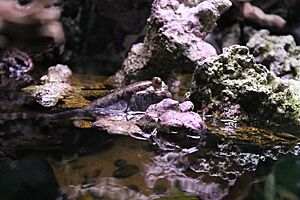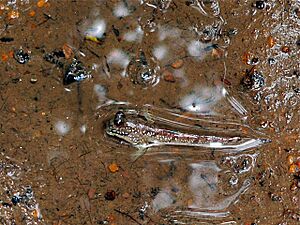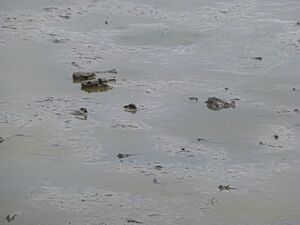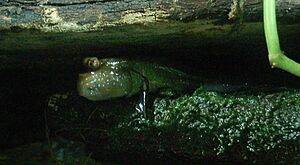Atlantic mudskipper facts for kids
Quick facts for kids Atlantic mudskipper |
|
|---|---|
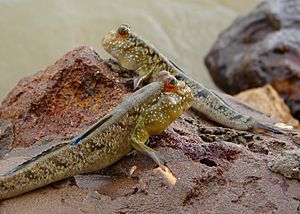 |
|
| Atlantic mudskippers (Periophthalmus barbarus) from Gambia | |
| Conservation status | |
| Scientific classification | |
| Synonyms | |
|
The Atlantic mudskipper (Periophthalmus barbarus) is a special type of mudskipper fish. It lives in fresh, salty, and slightly salty waters. You can find it along the tropical Atlantic coasts of Africa. It also lives in the Indian Ocean and as far as the western Pacific Ocean near Guam.
This fish gets its scientific name, Periophthalmus barbarus, from Greek words. Periophthalmus means "around the eye." This describes its eyes, which give it a very wide view. The Atlantic mudskipper is part of a group of fish called Periophthalmus. These fish have a single row of teeth that look like dog teeth.
Atlantic mudskippers can grow up to about 16 centimeters (6 inches) long. Like other mudskippers, they have eyes on top of their heads. Their strong fins help them move both on land and in water. They can skip, crawl, and even climb using their special fins.
These fish are semi-aquatic, meaning they spend time both in water and on land. They live on mudflats and in mangrove forests. They easily cross mud and sand when out of the water. Atlantic mudskippers are carnivores, meaning they eat other animals. They use a clever trick to catch food, which involves using water to suck their prey into their mouths.
Female mudskippers are ready to have babies when they are about 10.2 cm (4 inches) long. Males are ready at about 10.8 cm (4.2 inches). Atlantic mudskippers can live for about five years. People sometimes use them for food, fishing bait, or even for traditional medicine. Scientists say the Atlantic mudskipper is a 'Least Concern' species. This means it is not currently at risk of disappearing.
Contents
Where Do Atlantic Mudskippers Live?
Atlantic mudskippers are found all over West Africa. They live in mangrove swamps and mostly in slightly salty water near the coast. You can find them in countries like Angola, the Democratic Republic of the Congo, Cameroon, and Ghana.
Where these mudskippers live depends on if they can find enough food and safe places. Their hibernation (a kind of deep sleep) might also affect where they are found.
What's in a Name?
The scientific name Periophthalmus barbarus comes from Greek words. Peri means 'around', and ophthalmos means 'eye'. This refers to how the mudskipper's eyes are close together. This gives them a very wide view.
In Greek, barbarus means 'foreign'. This might be because the mudskipper looks different from other gobies. The common name 'mudskipper' comes from how they 'skip' across muddy areas.
How Are Mudskippers Classified?
Atlantic mudskippers belong to a group of fish called oxudercine gobies. All these fish can live both on land and in water. Atlantic mudskippers dig burrows in the mud. They use these burrows for safety and to have babies.
Oxudercine species are small to medium-sized fish. They have long bodies covered with small, smooth scales. You can also spot them by their eyes, which are on top of their heads. They also have pointy teeth that look like dog teeth. Their fins have spines, but the number of spines can be different.
There are 12 species in the Periophthalmus group. You can tell them apart from other oxudercine fish by their teeth. They have only one row of teeth on their upper jaw. Periophthalmus species also have up to 16 spines on their pectoral fins. All Periophthalmus fish live in places with mangroves or mudflats.
Atlantic mudskippers are different from other Periophthalmus species. They either have no spots or some white spots on their backs. You can also count the scales along their sides. Atlantic mudskippers have more than 90 scales.
The famous scientist Carl Linnaeus first described this species in 1766. He called it Gobius barbarus. Later, it was renamed Periophthalmus barbarus. This fish has also been known by other names in the past.
Body Features of the Atlantic Mudskipper
The Atlantic mudskipper can grow up to 16 centimeters (about 6 inches) long. Its body is covered with scales and a slimy layer of mucus. This mucus helps it stay wet. Atlantic mudskippers have more than 90 scales along their sides.
They can also hold water inside their gill chambers. This helps them breathe when they are out of the water. Mudskippers can open and close their gill chambers. This helps them control how much water they keep. They can also breathe through their skin, which is called cutaneous respiration.
Mudskippers have two strong pectoral fins. These fins help them 'skip' on land and stay steady in the water. They also have caudal fins, which help them swim. Their pelvic fins work with the pectoral fins to help them move on land. The pelvic fins can even act like a suction cup to help them stick to surfaces. Mudskippers can crawl and climb using these fins.
The eyes of the Atlantic mudskipper are perfect for life on land. They are close together, giving the fish a wide view. Each eye can move all around, 360 degrees, by itself. Their eyes are also high up on their heads. This means they can keep their eyes above water even when their body is submerged.
Underneath their eyes are small cup-like structures that hold water. These cups help keep their eyes wet when they are on land. When they roll their bodies, these cups cover their eyes. This helps them pick up water from the surface to keep their eyes lubricated. They roll more often when the air is dry, showing how important this is. Atlantic mudskippers also have special sensors in their nose and on their skin. These help them smell and sense things around them.
The Atlantic mudskipper can twist its mouth to grab prey. It has sharp teeth because it eats other animals. It has a short digestive system. This system helps it absorb nutrients from its food.
Mudskippers have a unique sense of smell. They have a small canal near their upper lip. This canal leads to a chamber that helps water flow through. This water flow helps them smell.
Female and male mudskippers have different genital papillae (small bumps) on their bellies. Females have rounder ones than males.
How Atlantic Mudskippers Live
Where They Live and How They Behave
Atlantic mudskippers are semi-aquatic animals. They live in places where the water is a bit salty, like river mouths and mudflats. They usually spend most of their day out of the water.
When the tide is low, mudskippers come out to find food. When the tide is high, they hide in their burrows. Their burrows can be up to 1.5 meters (5 feet) deep. These burrows keep them safe from predators. Burrows can even have a pocket of air inside. This lets the mudskipper breathe even if there's not much oxygen in the water.
Atlantic mudskippers can handle some harmful substances. These include things like cyanide and ammonia from pollution. For example, they can get rid of ammonia through their gills in very acidic places. They can also live in waters with different temperatures and salt levels.
Warm and humid weather is best for mudskippers. It helps them breathe through their skin and keep their body temperature steady. Their body temperature on the surface can be from 14 to 35 degrees celsius.
The Atlantic mudskipper is very protective of its home. It builds a wall of mud around its area. This area is usually about 1 meter (3 feet) long. This helps them protect their food and their space.
How They Hunt and Escape
The Atlantic mudskipper is a carnivore. It uses a surprise attack strategy to catch prey on land. When hunting, the mudskipper dips its body underwater. It leaves only its eyes out to spot and find its prey.
To ambush prey, mudskippers launch themselves onto land. They use their pectoral fins to jump and catch the prey with their mouths. If a predator threatens them on land, they quickly jump into the water or skip away on the mud. This is their 'fight or flight' reaction.
How They Eat
On land, the Atlantic mudskipper has a special way to eat. It covers its prey with water, then sucks the water and prey into its mouth. This is called the 'hydrodynamic tongue'. Mudskippers carry water in their mouths before they come out on land. This allows them to eat while on the mud.
In water, they eat by suction feeding. This is like how many other water animals eat. They quickly open their head and mouth, which creates a suction that pulls in food and water. The mudskipper changes how strong its suction is. It's stronger underwater than on land. Their mouth opens wider in water, possibly because of water pressure.
They also lunge forward while sucking in prey. The direction of their lunge is different depending on where they are. Underwater, they lunge straight forward. On land, they turn their body and mouth to eat prey from above. Atlantic mudskippers are diurnal, meaning they are active and eat during the day.
Atlantic mudskippers are not picky eaters. Bigger mudskippers eat bigger prey. This is because their mouths are larger. What they eat can also change based on their habitat and the season. They eat more during the dry season than the wet season. This is because there is less food available, so they need to be more flexible. Larger mudskippers eat more often because they are less likely to be eaten themselves.
What They Eat
The Atlantic mudskipper eats many different kinds of food. In the wild, they like to eat worms, crickets, flies, mealworms, beetles, small fish, and small crustaceans like crabs.
If you have mudskippers as pets, they can eat frozen foods like bloodworms or brine shrimp. They can also eat fish flakes. However, they cannot eat dried food because it makes their stomach swell up. It's best to feed them frozen food for a healthy diet.
How Atlantic Mudskippers Have Babies
Female mudskippers are ready to have babies when they are about 10.2 cm (4 inches) long. Males are ready at about 10.8 cm (4.2 inches). Atlantic mudskippers can lay eggs all year. But they mostly lay eggs between February and May for males, and March and May for females. This time is when there is lots of food for their young.
The more eggs a female mudskipper lays, the bigger she is. Females can lay thousands of eggs at once. However, many of these eggs get eaten by other animals. Mudskippers flood their burrows to make the eggs hatch. Only a small number of baby mudskippers survive because so many are eaten.
During courtship, a male mudskipper finds a female. They then go into the male's burrow to mate. After the female lays her eggs on the burrow wall, the male takes great care of them. The male Atlantic mudskipper will guard and look after the eggs inside the burrow.
Their Life Story
An Atlantic mudskipper usually lives for about five years. The eggs laid by the mother in the burrow hatch into tiny larvae. These larvae swim out of the burrow and float around for 30–50 days. Since adult mudskippers are territorial, young mudskippers hide in the mud. They stay hidden until they are big enough to protect their own territory.
How Humans Use Mudskippers
People use Atlantic mudskippers in several ways. They are used for food, bait, and sometimes kept as pets in aquariums. They are also used for medicine in some places. They are an important food fish for local indigenous peoples.
Too much fishing has caused their numbers to drop in some areas. Mudskippers can also be used to check for pollution in ocean areas. This is because they are sensitive to their environment. Their bodies can absorb harmful substances. Scientists can examine their organs to see if they are contaminated. Heavy metals like copper and iron often build up in their digestive system, gills, and skin. Another way to use them as a pollution indicator is to watch their growth and development. Changes in their growth can show if there's pollution.
What Threats Do They Face?
The Atlantic mudskipper is currently listed as a species of 'Least Concern'. This means it is not in immediate danger. However, their numbers can drop due to overfishing. Uncontrolled pollution and harmful fishing methods, like electric fishing, are also threats. The increase in city development in their habitats also threatens them.
Even though mudskippers can handle some cyanide, too much of it can kill them at any stage of their life. Pollution can also make mudskippers move to different areas. This can cause their local populations to shrink. If the number of Atlantic mudskippers changes, it can affect other animals. This includes the animals they eat and the animals that eat them.
Different local groups and cultures have ways to protect the Atlantic mudskipper. For example, the Higaonons people do not use harmful fishing methods or cyanide. This helps protect mudskippers and other water animals in their area. In Iligan city, Atlantic mudskippers can only be caught in a few specific places.
Some Atlantic mudskippers live in protected land and water areas. The best way to help them is to manage how many are caught when fishing.



